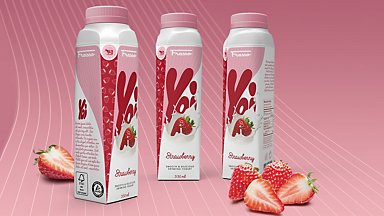The premise behind pouring seems simple enough. You open your package, tip out the product, and voilà! Yet there is a complex interplay of factors that lies behind pouring performance and ensuring an ideal experience for consumers, from the design of the opening and ergonomics to fluid dynamics, viscosity and air induction. This is the science behind achieving the perfect pour, and optimising consumers’ user experience.
Feel in control
It all starts from a simple concept. “When pouring, the consumer needs to feel in control,” says Karin Marcovecchio, Lead User Experience Researcher at Tetra Pak. “That they can decide the speed of the liquid, and where it’s going. Historically, many packages on the market didn’t deliver that – consumers felt the package dictated the pouring.”
Added to this are a number of variables, such as what they are pouring, where they are pouring it, and the size and shape of the package. And, of course, if the product is designed to be consumed on-the-go – if the consumer is drinking directly from the package, as opposed to pouring the product out – an entirely new set of parameters applies.
Pouring at home
When considering pouring products at home – from family packs, for example – a superior pouring experience exists in a sweet spot between speed and control. Consumer research indicates that the ideal flow rate is a speed that provides both that all-important feeling of control and a clean pour without any liquid wrapping.
It's crucial, then, to consider the size, shape, and design of the opening, as this is the main determinant of the pouring experience. We’ve undertaken extensive research to identify the optimum design guide, considering factors such as spout height, diameter, position from the package edge, edge geometry and cap design – all of this knowledge has been poured into the development of our broad range of caps and openings.
One key issue is that of “gulping”. “When you are pouring something, in order for the product to come out, air needs to get in; but if the product flow is interrupted, you can experience gulping. And that can cause spillage or the consumer missing their target,” says Marcovecchio. “So, when it comes to designing openings, we’re always looking to find the optimal size.”
“Avoiding gulping – and ensuring you have sufficient venting – is a combination of having the right size of opening alongside how fast you want to pour,” adds Anna Larsson, Business Insights Leader at Tetra Pak. “Plus, you have to consider the consumer expectation – sometimes it’s good to limit the flow rate, otherwise you run the risk of spillage.”
Designing for on-the-go consumption is significantly more complicated, mainly due to the increased number of variables. Firstly, while most people pour in a similar fashion – “pouring preferences are quite static,” says Marcovecchio – there are a number of distinct techniques to drinking directly from a package. Roughly speaking, there are three different modes of consumption – suck, pour, and pull.
Each technique involves a different mouth shape – thus, each technique requires a different size and shape for an optimum experience. A compromise that works for each is required – the opening height needs to be large enough that pullers can get their lip inside and have room on top to vent, yet small enough that suckers can comfortably cover the opening with their top lip.
The flow rate for drinking is also different to that for pouring – in order for it to feel comfortable, a significant reduction is required. For this reason, and considering the above three techniques, openings for on-the-go packages are smaller than those designed for pouring.
But, as Larsson notes, producers need to consider several alternative factors too. Consumers also pour from portion packages, which require a different flow rate. Then there’s the issue of whether the product will be consumed whilst still – sitting at your desk or at a picnic, say – as opposed to true on-the-go consumption such as walking or standing on public transport. “With the latter, the feeling of control is much more important because it’s far easier to spill,” she says.
There are also category considerations at play here. Something like cold tea, coffee, or certain types of juices will be “sipped” – all the better to savour the taste and flavour. But other categories, such as water, and sports and energy drinks, may be more gulped in order to refresh or quench a thirst. Products such as drinking yoghurt and plant-based beverages sit somewhere in between.
Given all the above, the design criteria and variables for on-the-go openings are quite considerable. Mouth engagement diameter, mouthpiece shape, package form, and rim design are all important – so too is the avoidance of unnecessary gulping. Then there’s the location on the package. “DreamCap™ is positioned very close to the edge and has a little lip form at the very front,” says Larsson. “That was about comfort and optimising the drink-from experience for the consumer.”
Producers also need to consider the size of the opening in relation to the package. “On some packages, there isn’t the physical space to put a screw cap because there are folds and seals. Then you need to find another technical solution to ensure a good pour.”
Ultimately, says Larsson, “our innovation is largely category-driven from the start, and then we translate that into a portfolio that fits those categories.” Tetra Top, and ambient drinking yoghurt with particles, is one such example. “Tetra Top had a nice space to play in there, because it's already inherently large, with a big cap, which gives you a nice drinking experience. This is what drives our product development – we’re always looking for better solutions that improve the consumer experience.”








